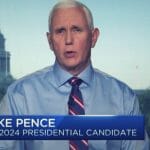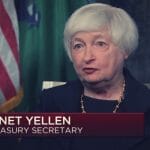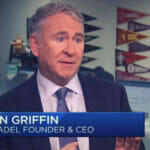Following is the unofficial transcript of a CNBC interview with Kleiner Perkins Chair & “Speed & Scale” Co-Author John Doerr and Fmr. Deputy CTO of the United States & “Speed & Scale” Co-Author Ryan Panchadsaram at CNBC’s ESG Impact conference, which took place today, Thursday, October 28th. Video from the interview will be available at cnbc.com/esg-impact/.
Q3 2021 hedge fund letters, conferences and more
Interview With John Doerr and Ryan Panchadsaram
ANDREW ROSS SORKIN: Thank you, sir and it is great to see both of you. We are, we are with two legends, if you will, for this important conversation about climate and what are really the opportunities to get there. Yeah, John?
JOHN DOERR: We're, we're with three legends Andrew. You're one also.
SORKIN: You know, I'm just pretending to to be here with you. Let's talk about this because both of you have written a book that's about to come out called “Speed & Scale” and John, you talk about the plan to cut carbon emissions and reach net zero of course by 2050. Everybody's trying to do it. Everybody wants that to be the goal. The question, of course, is how do you get there and you have some ideas. Top level, what's the most important thing that that investors and the folks who are listening need to be thinking about?
DOERR: The most important thing that we need is a plan. There are lots of goals. There's lots of ambition. We, we are not on track to meet a net zero goal by 2050. The UN Emissions Gap Report just out in the last couple of days said that if we achieve the pledges from the world's countries, will reduce emissions by 2030 by just 7%. We need to reduce them by 50% to get to a one and a half degrees C world. So this is an existential crisis. It's an economic, unparalleled economic opportunity. And it's, it's really the challenge of our lifetimes.
SORKIN: Ryan, you've said that currently the plan doesn't really even begin to get to there to maybe 2070 at best. In terms of the, the public private role that we can have here given your experience in Washington and the valley now, how do you see it what, what is the opportunity set in front of us?
RYAN PANCHADSARAM: Totally. So when you look at the plan, right, the book outlines a plan that has six big solutions you know to get to net zero but the plan also includes four different levers that we can pull on, right, everything from winning the policy and politics, right. Government set the direction for how a country should like the future for essentially giving businesses confidence, consumer confidence, but governments have to make those hard commitments Andrew and then follow through on them, but that's just one of the many levers. We have to also turn movements into action from the ballot box to the corporate boardroom, as well as invest and innovate. So these are the four levers that we have. We've got to pull on all four equally. And if we do, we can get to net zero not in 2070, but in that 2050 timeframe.
SORKIN: Okay, but John, you break down the, the climate action as far as I can tell in six parts, electrifying transportation, decarbonizing the grid with alternatives like wind, solar nuclear, fixing food, the food industry, protecting nature, cleaning up businesses and removing carbon. You got, you have a slide better yet you brought props. So okay, but let's talk about what's doable in terms of the priority there on that, on that sheet. How you do it, what's, what's the low hanging fruit? What's the hard stuff?
DOERR: So this whole plan for our audience is available for free. It fits on one page. It's at speedandscale.com. And the biggest single thing we can do is decarbonize the grid around the world. That'll eliminate 24 gigatons out of our 59 gigaton target. And that means moving to zero emissions technologies across the board like wind and solar instead of coal and gas. But the key to these six objectives is the magic, the power is in the key results. So for each of these, there's a concrete measurable time bound goal which must be achieved. If we don't achieve that goal, we'll find out early on that we're off track and we can make adjustments. None of these are going to be easy and each of them is a realm all unto itself but the difference between goals and having an action plan is having real key results.
SORKIN: Ryan maybe help us with this with it, with his prop as well though. In term he said sort of the low hanging fruit was that was the grid perhaps I don't know how low hanging fruit that is. Let's also talk about the hard stuff on that list. What is the hardest thing on that list in your mind?
PANCHADSARAM: Totally. The hardest stuff is actually objective number six, right, removing the carbon that's left but like the 1, 2, 3 punch that gets us almost 80% of the way there is that switching to clean energy, getting gas out of our buildings, switching to electric vehicles, stopping deforestation, right, those just three very concrete things reduce the emissions aggressively but in writing the book, looking at the models, whether it's the IPCC work or our work, we're still gonna be left with five to 10 gigatons of emissions a year in 2050. And so we've got to do the hard thing which is carbon removal, both nature based as well as engineered, and we've got to start doing that now and doing it well. But it shouldn't be the crutch Andrew, right, like companies today, they're making net zero commitments. They can't say, Well, I'm buying offsets. I'm doing carbon removal. For those companies, they first have to look at their emissions, their carbon footprint and say, how do we cut? Then how do we conserve and then and then they can leave on the, lean on the carbon removal pieces.
SORKIN: John, I saw a tweet of yours. You said, “In the course of writing this book, I was reminded of a quote that helped inspire the green growth fund.” The quote, “The green economy is poised to be the mother of all markets. It's the economic investment opportunity of a lifetime.” It very well may be one of the great opportunities of a lifetime. The question though is how do you pick which ones are the right opportunities? Because as you know, over the last 20 years, there have been a lot of people who've invested in this space and unfortunately for them, they have lost.
DOERR: Well, I think the crucial thing is to be data driven and to go for the gigatons, go for the largest economic opportunities that exist. One of my favorite ones is electrification of transportation and in particular, the holy grail of that revolution is advanced batteries, battery breakthroughs. That's the equivalent of the microprocessor for this new clean energy future. Some estimates are that market is $400 billion per year for 20 years to replace all the internal combustion engines with electric vehicles. If that's not a monster market, I don't know what is. But Larry Fink is on record. He's, he's forecasting that there will be 1,000 unicorns coming out of the climate clean tech energy revolution. I agree with that.
SORKIN: Hey Ryan, one of the things I want to ask is effectively a public policy question.
PANCHADSARAM: Oh, yeah.
SORKIN: One is the question, one is the question of what do you do about China, India and other places that are not doing this let's just say as fast as we may be doing it? The other is, and we're already seeing it right now, the price of oil today is going up materially and there's a debate and discussion now that that may be a function of the fact that we are not either investing fast enough in some of these renewables or we're moving too fast to effectively de-invest in fossil fuels.
PANCHADSARAM: Yeah, I’ll take the last one than the first one. So, when you look at oil prices, the fluctuation in gas, that's always what's happened with scarce resources, right. If we invest in more solar and more wind and more battery storage, those are things that are predictable, right. We've gone to wars over the price fluctuations of oil and gas and so to kind of blame it on renewables is pretty unfair. And so when we think about how we navigate this energy crisis, we're going to have to navigate it well, but when you think the 2022 and beyond, it's not about drilling more or finding more gas, it's deploying more clean energy because we can rely on it. On the first piece about the US, China, India and other countries, I think there's something that's pretty clear is that the alpha emitters, like ourselves in the US, we've got to go first, right. We've got to show the world it's possible and in the course of that, and by deploying more clean energy, we get to drive down the costs. The wealthy nations like China and Europe, they got to be on that train as well too, right. There's no more excuses. We've got to lead and the kind of competitive nature here too from a policy side is likely the countries that lead on this transition are going to create the businesses that matter the most around them, right, the valuable ones. And so it is effectively a race. A race who can create and own these markets of the future.
SORKIN: Right. Hey John, I noticed it seemed like you wanted to jump in on this very issue and debate around whether we are either de-investing too quickly or investing too slowly. Steve Schwarzman runs Blackstone just warned yesterday he said that he believes this energy shortage, he believes is gonna ultimately lead to unrest and call for government, it will, will result in government intervention perhaps on the other side of the green debate.
DOERR: Well, this is a revolution, this and in revolutions, there are winners and there are losers. It's not some kind of green kumbaya party that we're having among all the, all the participants. China made a strategic decision. They said they wanted to own the solar photovoltaic future. And so as a matter of policy, internal demand and global economic leadership, they funded solar manufacturers in every province and in every region and the result today is that they're 80% of the solar market. Now hot on their heels is India. Modi has declared he wants to install 450 gigawatts of solar by 2030. That would make him as large as the US market is for solar and they intend to distribute that globally to be a global supplier and powerhouse. So the energy transition will be rugged. We must though pay attention to environmental justice to make sure that populations that historically have been left behind in this transition have an opportunity to participate in the jobs of the new clean energy future.
SORKIN: Right. John, you've always invested in some of the great entrepreneurs of our time so I have an investment and valuation question which is here we have Tesla, which just this week surpassed a trillion dollars in valuation that after Hertz announced it was going to be ordering 100,000 vehicles and I'm curious how you see that valuation. There's a lot of people that are buying into Tesla Inc (NASDAQ:TSLA) and buying into other companies that are in this space because there are so few of them.
DOERR: Well, I think the fundamental driving this is the size of the market and the excellence of the product. If you haven't driven a Tesla, people aren't buying Tesla because it's green. They're buying it because it's a great automobile and the powerful thing that Tesla has done beyond creating a trillion dollar company that's worth as much as their next four competitors is they've put the global auto industry on notice that the future of electric transportation is what consumers will demand when we get cost and prices to be competitive globally. For an electric vehicle to prosper in India, you've got to displace an internal combustion vehicle with an average price of $12,000 to $14,000. We are not there yet in terms of batteries and we are not there yet today in terms of the market penetration. Globally, electric vehicles are about 4% of the worldwide fleet. That gives you a sense of how far we have to go and why I think the Tesla bulls are probably right.
SORKIN: Probably right so I was gonna ask you is the valuation right that you know you often talk about being a first mover. Their first mover 5, 10 years from now, you want to hope that lots of other automobile makers are also following that lead but the question is how big, how big will the market ultimately be?
DOERR: I think ultimately transportation will be electric globally. That's what the Speed & Scale plan calls for. As an anecdote, I think it was just a week ago that Elon was the guest of the leadership of Volkswagen. They want to know how that company moves so nimbly and they are committed to being a global leader. I believe they will be in the transportation future.
SORKIN: Ryan, you said that the hardest piece of this is going to be the carbon capture piece and, and it's critical to so many of the plans that are out there to getting us to 2050 the right way. A number of major corporations have also made some pretty ambitious plans that require carbon capture. What are the most promising technologies that you found thus far in that space?
PANCHADSARAM: Yeah, the most promising technologies in the carbon removal space, right, like using engineer mechanisms to pull carbon from the sky. You got the direct air capture world, right. This is climate works, carbon engineering, you've got other companies like Charm and Heirloom that are using other approaches as well too. I mean this market is so young Andrew, right, there are barely 4,000 tones that have been actually pulled out from the sky and we've got to get to 5 billion tons. And so the market opportunity here over the course of the next you know two decades is going to be quite incredible. But it's got to start now, right. That market needs to be instigated and the work you're seeing from Microsoft and Stripe and others to pay ahead, right, to pay that green premium for carbon removal because the cost something on the order of like 600 bucks a ton today is what's getting things kick started. We're going to need things like a price on carbon to actually make it, to drive down that actual cost from 600 to 100 to maybe 50 as time goes on and people start to scale these things up. But that's the kind of nut of it, we're going to need it. There's going to be a market there. The companies that are paying ahead are doing the right thing they're instigating but there's also going to have to be truly a cost on polluting carbon that goes towards carbon removal.
DOERR: So Andrew, besides—
SORKIN: Yes sir. Go ahead.
DOERR: I was just gonna say besides, besides the mechanical or engineered approaches, there are natural approaches to remove carbon such as growing greater kelp forests which can rely on the awesome powers of nature to capture and sequester this stubborn carbon that will be leftover.
SORKIN: Gentlemen, I want to thank—
PANCHADSARAM: One thing I—
SORKIN: Go ahead. We're gonna leave it there in about a second but, but let's, tell us the one thing about technology.
PANCHADSARAM: Oh yeah, the one thing though to look at too is there are carbon capture technologies when in the use of natural gas and other places but always look at those with a skeptical eye because of the added cost of that compared to the renewable option, the cleaner one, and the truth is you're going to find that the market wins on that side, Andrew.
SORKIN: Okay, Ryan and John. The book is called “Speed & Scale.” Appreciate it. Congratulations on the on the book. Hope to see you guys in person very, very soon. Thanks.
DOERR: Let's do that.













